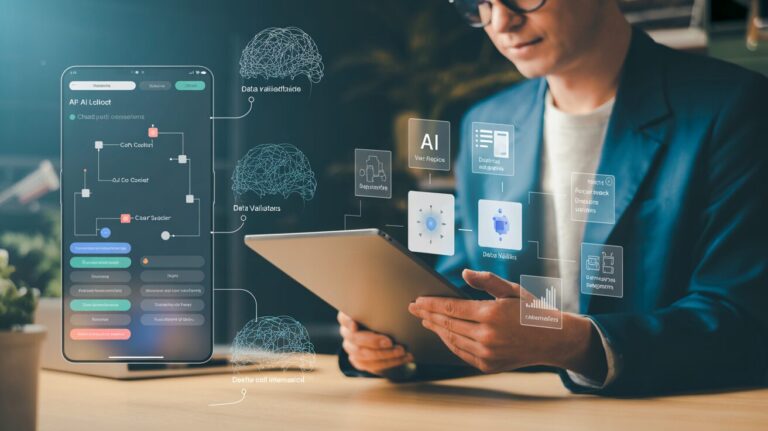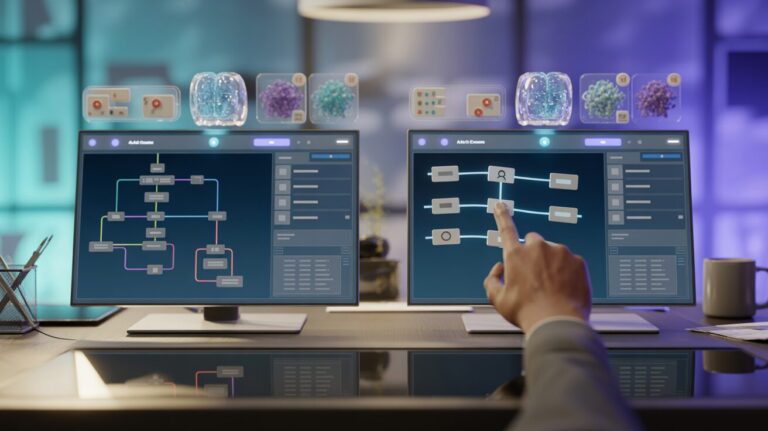Table Of Contents
- Introduction
- What Are AI Tools for Education?
- Benefits of AI in Education
- Essential AI Tools for Educators
- Getting Started with AI as an Educator
- Overcoming Common Challenges
- Building Custom AI Solutions Without Coding
- Future of AI in Education
- Conclusion
What is AI Tools for Educators? A Comprehensive Beginner’s Guide
The education landscape is undergoing a profound transformation, and artificial intelligence (AI) is at the forefront of this revolution. For educators who haven’t ventured into the world of AI yet, the concept might seem overwhelming or technically complex. The good news? You don’t need to be a computer scientist or coding expert to harness the power of AI in your classroom.
Today’s educational AI tools are increasingly designed with teachers in mind, offering intuitive interfaces that focus on pedagogical outcomes rather than technical complexities. Whether you’re teaching kindergarteners or graduate students, there’s an AI solution that can enhance your teaching methods, personalize student learning experiences, and free up valuable time for what matters most—meaningful human connection with your students.
In this comprehensive guide, we’ll demystify AI tools for education, explore their practical applications, and show you how to get started with confidence—even if you have zero technical background. By the end, you’ll understand not just what these tools can do, but how you can begin implementing them in your own educational setting to create more engaging, effective learning experiences.
AI Tools for Educators: The Complete Guide
A visual breakdown of how artificial intelligence is transforming education
What Are AI Education Tools?
Software applications that use machine learning, natural language processing, and predictive analytics to enhance teaching and learning.
- ✓They adapt to individual student needs and learning styles
- ✓They analyze patterns in learning behavior
- ✓They improve over time through continued interaction
Key Benefits for Educators
Personalized Learning at Scale
Deliver customized experiences to each student simultaneously
Time-saving Automation
Automate routine tasks like grading and answering FAQs
Data-driven Insights
Analyze student performance to optimize teaching methods
Essential AI Tool Categories for Educators
Personalized Learning Tools
Adapt to individual needs and learning styles
Assessment & Feedback
Automate grading and provide actionable feedback
Content Creation
Generate customized learning materials and resources
Administrative Efficiency
Streamline scheduling, attendance, and communication
Getting Started with AI (No Coding Required)
Identify Your Challenges
Determine your biggest pain points in teaching that AI could solve
Start with User-Friendly Tools
Choose platforms designed specifically for educators without technical backgrounds
Pilot Before Full Implementation
Test with a small group before rolling out to all students
Build Custom Solutions
Use no-code platforms like Estha to create AI tools tailored to your specific needs
Ready to Create Your Own AI Education Tools?
Build custom AI applications in minutes—no coding required
What Are AI Tools for Education?
AI tools for education are software applications and platforms that leverage artificial intelligence technologies to enhance teaching and learning processes. Unlike traditional educational software, AI-powered tools can adapt to individual student needs, analyze patterns in learning behavior, and provide personalized recommendations that would be impossible for a human teacher to scale across an entire classroom.
At their core, these tools employ various AI technologies including machine learning (which allows systems to learn from data), natural language processing (enabling computers to understand human language), and predictive analytics (forecasting outcomes based on historical data). The result is a suite of intelligent assistants that can supplement and enhance a teacher’s capabilities rather than replace them.
Modern educational AI tools range from simple chatbots that can answer student questions to sophisticated platforms that can create custom learning pathways, generate instructional content, provide automated grading, or even simulate scientific experiments. What makes them particularly valuable in today’s educational environment is their ability to adapt to each student’s pace, learning style, and knowledge gaps.
The key distinction between AI tools and regular educational technology is their ability to evolve and improve over time based on interactions. They’re not static programs but dynamic systems that become more effective the more they’re used, learning from both successes and failures to continuously refine their approaches.
Benefits of AI in Education
The integration of AI into educational settings offers numerous advantages for both educators and students. Understanding these benefits can help you identify which tools might be most valuable for your specific teaching context.
Personalized Learning at Scale: Perhaps the most significant benefit of AI in education is the ability to deliver customized learning experiences to every student simultaneously. AI can analyze individual learning patterns, identify knowledge gaps, and adjust content delivery to match each student’s needs—something that would be impossible for even the most dedicated teacher to accomplish manually across an entire classroom.
Time-saving Automation: AI can handle routine tasks like grading multiple-choice assessments, checking for plagiarism, or answering frequently asked questions. This automation frees educators to focus on higher-value activities like providing nuanced feedback, designing engaging lessons, or working individually with students who need extra support.
Data-driven Insights: AI tools can analyze student performance data to identify patterns that might not be immediately apparent to teachers. These insights can help educators understand which concepts students are struggling with, which teaching methods are most effective, and how to optimize curriculum design for better outcomes.
Increased Accessibility: AI can make education more accessible for students with diverse learning needs. From text-to-speech for students with visual impairments to language translation for ESL learners, AI helps break down barriers to learning.
24/7 Learning Support: AI-powered tutoring systems and chatbots can provide immediate assistance to students outside regular classroom hours, ensuring help is available whenever students are ready to learn.
Enhanced Engagement: Interactive AI tools can make learning more engaging through gamification, adaptive challenges, and immediate feedback that keeps students motivated and invested in their progress.
Essential AI Tools for Educators
The world of educational AI tools is vast and growing rapidly. Let’s explore some of the most practical and impactful categories of AI tools that educators can leverage in their teaching practice.
Personalized Learning Tools
Adaptive learning platforms use AI to tailor educational content to each student’s progress, learning style, and knowledge gaps. These systems continuously assess student performance, adjust difficulty levels, and recommend resources based on individual needs.
For example, an adaptive math learning system might offer additional practice problems in specific areas where a student is struggling, while allowing them to progress more quickly through concepts they’ve already mastered. This personalization ensures that advanced students remain challenged while struggling students receive the support they need.
The most effective personalized learning tools provide detailed analytics for teachers, allowing them to monitor individual progress and identify when human intervention might be necessary. They serve as powerful classroom assistants rather than replacements for teacher guidance.
Assessment and Feedback Tools
Grading and providing thoughtful feedback are among the most time-consuming aspects of teaching. AI-powered assessment tools can dramatically reduce this burden while maintaining—and sometimes improving—quality.
Automated grading systems can now evaluate not just multiple-choice questions but also short answers and even essays. These systems assess factors like argumentation quality, evidence use, and writing coherence, providing detailed feedback that helps students improve their work.
Real-time assessment tools can monitor student work as it happens, identifying confusion immediately rather than waiting for formal assessments. For instance, if multiple students are struggling with the same concept during an interactive lesson, the AI can alert the teacher so they can provide clarification before misconceptions become entrenched.
Plagiarism detection has also been revolutionized by AI, with sophisticated systems that can identify not just direct copying but also paraphrasing and idea theft from multiple sources across the internet.
Content Creation Tools
Developing engaging, differentiated learning materials is another area where AI excels. Content creation tools can generate customized worksheets, quizzes, presentations, and even lesson plans based on your curriculum objectives and student needs.
AI image generators can create custom illustrations for learning materials that precisely match your instructional needs. Text-to-video tools can transform lesson content into engaging visual presentations. Automated translation systems can make materials accessible to language learners or for multilingual classrooms.
Some systems can even take existing content and automatically adapt it for different reading levels, learning styles, or subject emphases—allowing you to create differentiated materials for diverse learners without starting from scratch each time.
Administrative Efficiency Tools
Beyond direct classroom applications, AI can streamline many administrative tasks that consume educators’ time. Intelligent scheduling systems can optimize timetables based on resource availability and student needs. Attendance tracking can be automated through facial recognition or other AI-powered verification methods.
Communication tools enhanced with AI can handle routine parent inquiries, schedule conferences, translate messages to bridge language barriers, and even predict which students might benefit from additional family outreach based on performance patterns.
Student information systems with AI capabilities can flag potential issues—like sudden changes in attendance patterns or academic performance—enabling earlier intervention before small problems become major obstacles to learning.
Getting Started with AI as an Educator
Integrating AI tools into your teaching practice doesn’t have to be overwhelming. The key is to start small, focus on specific problems you want to solve, and gradually expand your AI toolkit as you gain comfort and confidence.
Identify Your Biggest Pain Points: Begin by considering which aspects of your teaching workload are most time-consuming or challenging. Is it grading? Content creation? Providing personalized support to students with diverse needs? Choose tools that address your most pressing challenges first.
Start with User-Friendly Options: Many educational AI tools are specifically designed for non-technical users. Look for platforms with intuitive interfaces, substantial support resources, and strong user communities where you can ask questions and share experiences.
Seek Professional Development: Many schools and educational organizations offer training specifically for AI integration. These resources can accelerate your learning curve and connect you with peers on similar journeys.
Pilot Before Full Implementation: Test new tools with a small group of students or for a limited portion of your curriculum before rolling them out more broadly. This approach allows you to work through any challenges on a manageable scale and gather evidence about effectiveness.
Involve Students in the Process: Many students are naturally curious about technology. Explaining how AI tools work, their benefits, and their limitations can be an educational opportunity in itself and helps develop critical digital literacy skills.
Overcoming Common Challenges
While the benefits of AI in education are substantial, educators often encounter several common challenges when implementing these tools. Understanding these potential obstacles in advance can help you navigate them successfully.
Technical Barriers: Many educators worry about having sufficient technical expertise to implement AI tools effectively. The solution is to look for tools specifically designed for educators without technical backgrounds. Modern educational AI platforms increasingly prioritize user-friendly interfaces over technical complexity.
Integration with Existing Systems: New tools need to work seamlessly with your current digital ecosystem. Before adopting any AI solution, verify its compatibility with your learning management system, student information system, and other core platforms.
Cost Concerns: Budget constraints are a reality for most educational institutions. Fortunately, many effective AI tools offer free tiers or educational discounts. Start with cost-effective solutions that demonstrate clear value, which can help build the case for investment in more comprehensive systems if needed.
Data Privacy and Security: AI tools typically require access to student data to function effectively, raising legitimate privacy concerns. Always verify that any platform you consider complies with relevant educational privacy regulations (like FERPA in the US) and implements strong security measures to protect student information.
Maintaining the Human Element: Perhaps the most important challenge is ensuring that AI tools enhance rather than replace the critical human connections at the heart of effective education. The most successful implementations use AI to handle routine tasks while creating more time and space for meaningful human interaction.
Building Custom AI Solutions Without Coding
While many excellent pre-built AI tools for educators exist, they sometimes don’t address the specific needs of your unique teaching context, curriculum, or student population. Traditionally, creating custom AI solutions required extensive coding knowledge and technical expertise, putting it beyond the reach of most educators.
Today, no-code AI platforms are changing this dynamic, empowering educators to create customized AI applications without writing a single line of code. Platforms like Estha allow you to build personalized AI solutions through intuitive visual interfaces, making custom AI development accessible to anyone regardless of technical background.
With no-code AI platforms, educators can create:
Custom Subject-Specific Chatbots: Develop virtual assistants that understand the specific terminology, concepts, and common questions in your subject area. These can provide immediate assistance to students working through assignments or studying independently.
Interactive Learning Experiences: Create AI-powered quizzes and assessments that adapt based on student responses, providing personalized feedback and branching content paths based on demonstrated knowledge and misconceptions.
Virtual Tutors: Build AI tutors that reflect your teaching style and approach, providing consistent support even outside classroom hours.
Specialized Content Generators: Develop tools that create customized exercises, examples, or practice problems tailored to your curriculum and pedagogical approach.
The process typically involves using a drag-drop-link interface to connect pre-built AI components, customize their behavior based on your needs, and embed the finished application in your existing digital learning environment. This approach combines the power of AI with your unique educational expertise and understanding of your students’ needs.
Future of AI in Education
The educational AI landscape continues to evolve rapidly, with several emerging trends poised to shape the classroom of tomorrow. Understanding these developments can help educators prepare for and contribute to the future of teaching and learning.
Increased Personalization: Future AI systems will offer even more granular personalization, potentially creating unique learning pathways for each student that continuously adapt based on performance, engagement, emotional state, and learning preferences.
Emotional Intelligence: Next-generation educational AI will increasingly incorporate emotional intelligence, detecting student frustration, confusion, or disengagement and responding appropriately—either by adjusting the learning experience or alerting the teacher when human intervention is needed.
Immersive Learning: The combination of AI with virtual and augmented reality will enable more immersive learning experiences, from virtual field trips guided by AI to complex simulations that adapt to student actions and decisions.
Lifelong Learning Support: As careers and required skills evolve more rapidly, AI will increasingly support lifelong learning by identifying skill gaps, recommending personalized learning opportunities, and helping individuals navigate educational pathways aligned with their career goals.
Collaborative Intelligence: Rather than viewing AI as a replacement for human teaching, the most promising future lies in collaborative intelligence—where human educators and AI systems each contribute their unique strengths to create educational experiences better than either could provide alone.
Conclusion
AI tools for education represent a paradigm shift in how teaching and learning can be approached, offering unprecedented opportunities to personalize instruction, reduce administrative burdens, and enhance educational outcomes. While the technology continues to evolve rapidly, the most successful implementations will always be those that combine AI capabilities with human educational expertise.
As an educator exploring these tools, remember that you don’t need to become a technical expert to leverage AI effectively. The goal should always be to find and implement solutions that enhance your teaching practice rather than fundamentally changing it—tools that handle routine tasks so you can focus on the creative, interpersonal aspects of education that are uniquely human.
Whether you’re using pre-built educational AI platforms or creating custom solutions with no-code tools, the key is to maintain a clear focus on pedagogical goals and student needs. When implemented thoughtfully, AI tools don’t replace educators; they empower them to be more effective, engaged, and connected with their students.
The future of education isn’t about choosing between human teachers and artificial intelligence—it’s about harnessing the best of both to create learning experiences that were never before possible.
Ready to Create Your Own AI Tools for Education?
Build custom AI applications tailored to your specific teaching needs—no coding required.



